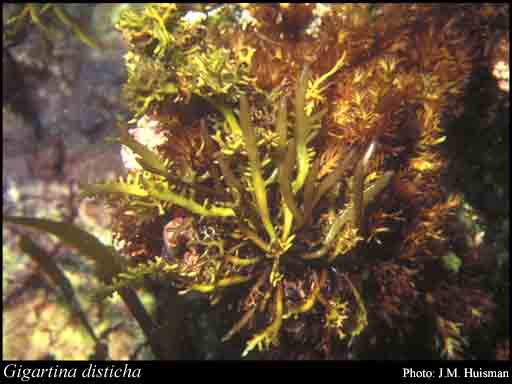- Reference
- Bot.Zeit. 55 (1845)
- Conservation Code
- Not threatened
- Naturalised Status
- Native to Western Australia
- Name Status
- Current

Scientific Description
Habit and structure. Thallus medium to dark red, fading to yellow-red, erect and moderately rigid, drying cartilaginous, 20–30 cm high, with one to several fronds. Fronds subdichotomous (occasionally laterally branched), often subpinnate above, axes compressed, 3–6(–8) mm broad, with a terete stipe, above bearing distichous, short, fertile, laterals, alternate to opposite, 3–10 mm long and (0.5–)1–1.5 mm in diameter, with a terete lower part, terete or slightly compressed above, varying from simple to 2 or 3 times furcate, apices rounded to subacute. Holdfast discoid, 1–6(–10) mm across; epilithic. Structure of a cortex of anticlinal, subdichotomous filaments, outer cells 1–2 µm in diameter and L/D 2–4, and a medulla of anastomosing filaments, slender near apices, soon becoming 5–10(–20) µmthick.
Reproduction. Sexual thalli monoecious. Carpogonial branches 3-celled, borne on an inner cortical (supporting) cell, occurring as scattered groups near the apex of the short laterals. Cystocarps subterminal in clavate branchlets, usually single, 1–1.5 mm across, with a distinct cortical depression, without involucral ramuli, with diffuse enveloping tissue (with inner cells often connected to gonimoblast filaments but without transverse filaments) and the carposporophyte with a filamentous matrix, numerous scattered larger cells, and clusters of ovoid carposporangia 14–18 µmin diameter, liberated by cortical disintegration. Spermatangial sori inconspicuous, adjacent to developing cystocarps, with elongate spermatangia cut off from surface cortical cells and each producing a single ovoid spermatium about 1 µm in diameter. Tetrasporangial sori surrounding the upper parts of the lateral branchlets, 2–4 mm long, tetrasporangia transformed primarily from outer medullary cells in rows of 3–6, with some cut off laterally, ovoid, 25–30 µm in diameter, cruciately divided. Mixed phase plants sometimes occur, with cystocarps and tetrasporangia on the same plant.
Distribution.Fremantle, W. Aust.,to the Fitzroy River mouth, Vic.
Habitat. G. disticha is found mainly in deeper water (10–20 m) on rough-water coasts.
[After Womersley, Mar. Benthic Fl. Southern Australia IIIA: 310–312 (1994)]
Distribution
- IBRA Regions
- Swan Coastal Plain, Warren.
- IBRA Subregions
- Perth, Warren.
- IMCRA Regions
- Central West Coast, Leeuwin-Naturaliste.
- Local Government Areas (LGAs)
- Augusta Margaret River, Bunbury, Busselton, Capel, Cockburn, Cottesloe, Dandaragan, Irwin, Joondalup, Mandurah, Manjimup, Rockingham.